Red-leaf hibiscus
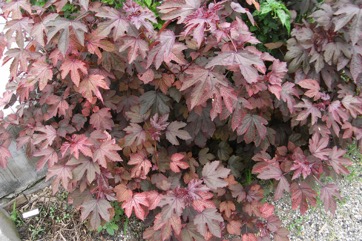
A tropical plant. It is best in sites sheltered from strong winds. It needs fertile, well-drained soil and full sun. It can grow in arid places. In XTBG Yunnan.
Also known as:
Alagi, Asam susur, Damudamu, False roselle, Gamet, Gwali, Gwanya, Kembang sepatu afrika, Kololwe, Limanda, Linyololo, Lumaka, Lumanda, Makawang kulo, Ngaingai, Nsa bwaki, Som kop, Thakhlao maikhri gajao, Usse
Synonyms
- Hibiscus eetveldeanus De Wild. & T. Durand
Edible Portion
- Leaves, Fruit, Spice, Vegetable, Root, Flowers
Where does Red-leaf hibiscus grow?
Found in: Africa, Angola, Asia, Brazil, Burundi, Cameroon, Central Africa, China, Congo DR, Côte d'Ivoire, Dominican Republic, East Africa, Ethiopia, Hawaii, India, Indonesia, Ivory Coast, Kenya, Malawi, Mozambique, Nigeria, Northeastern India, Pacific, Pan tropical, Rwanda, Sao Tome and Principe, SE Asia, Senegal, Sierra Leone, South Africa, Southern Africa, Sudan, Tanzania, Uganda, United States, West Africa, West Indies, Zambia, Zimbabwe
Notes: There are about 220 Hibiscus species. It is resistant to root knot nematode.
Status: It is a commercially cultivated vegetable. It is a popular leafy green. It is grown as a vegetable in Angola. Leaves are sold in local markets.
Growing Red-leaf hibiscus
Cultivation: Plants are grown from seeds. Seed are planted about 1 cm deep and 1 m apart. It can also be grown by cuttings. It can be grown as a hedge.
Edible Uses: The leaves are eaten raw or cooked. They can be steamed or put into soups and stews. They are often wilted in the sun. The young pods can also be used. The seeds can be roasted and used as a coffee drink. The flower petals are eaten as a drink. The root can be eaten but has little taste and is fibrous.
Production: By pruning as a hedge, large amounts of leaves can be produced in a small space. The leaves are usually collected in the rainy season. Young leaves are plucked from the plant.
Nutrition Info
per 100g edible portion| Edible Part | Energy (kcal) | Protein (g) | Iron (mg) | Vitamin A (ug) | Vitamin c (mg) | Zinc (mg) | % Water |
|---|---|---|---|---|---|---|---|
| Leaves | - | - | - | 78 | - | - |
Red-leaf hibiscus Photos

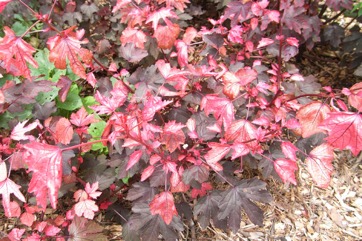
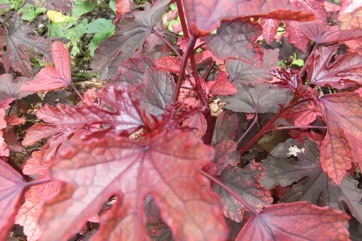
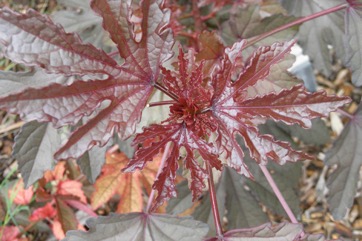
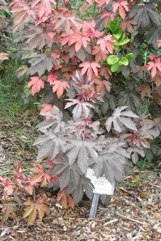
References
Acipa, A. et al, 2013, Nutritional Profile of some Selected Food Plants of Otwal and Ngai Counties, Oyam District, Northern Uganda. African Journal or Food, Agriculture, Nutrition and Development. 13(2)
Agea, J. G., et al 2011, Wild and Semi-wild Food Plants of Bunyoro-Kitara Kingdom of Uganda: etc. Environmental Research Journal 5(2) 74-86
Andabati, B., & Muyonga, J., 2014, Phenolic content and antioxidant activity of selected Ugandian traditional medicinal foods. African Journal of Food Science. 8(8), pp 427-434
Arora, R. K., 2014, Diversity in Underutilized Plant Species - An Asia-Pacific Perspective. Bioversity International. p 41
Brickell, C. (Ed.), 1999, The Royal Horticultural Society A-Z Encyclopedia of Garden Plants. Convent Garden Books. p 521
Burkill, H. M., 1985, The useful plants of west tropical Africa, Vol. 4. Kew.
Cat. afr. pl. 1:73. 1896 (Welw. ex Ficalho, Bol. Soc. Geogr. Lisb. 2:608. 1881, nom. nudum)
Facciola, S., 1998, Cornucopia 2: a Source Book of Edible Plants. Kampong Publications, p 147
Food Composition Tables for use in Africa FAO http://www.fao.org/infoods/directory No. 690
Fowler, D. G., 2007, Zambian Plants: Their Vernacular Names and Uses. Kew. p 45
Fox, F. W. & Young, M. E. N., 1982, Food from the Veld. Delta Books. p 261
Godfrey, J. et al, 2013, Harvesting, preparationand preservation of commonly consumed wild and semi-wild food plants in Bunyoro-Kitara Kingdom, Uganda. Int. J. Med. Arom. Plants. Vol.3 No.2 pp 262-282
Goode, P., 1989, Edible Plants of Uganda. FAO p 39
Grubben, G. J. H. and Denton, O. A. (eds), 2004, Plant Resources of Tropical Africa 2. Vegetables. PROTA, Wageningen, Netherlands. p 312
Jardin, C., 1970, List of Foods Used In Africa, FAO Nutrition Information Document Series No 2.p 81
Kays, S. J., and Dias, J. C. S., 1995, Common Names of Commercially Cultivated Vegetables of the World in 15 languages. Economic Botany, Vol. 49, No. 2, pp. 115-152
Koni, J. & Bostoen, K., 2008, Noms et usages des plantes utiles chez les Nsong. (RD Congo, Bandundu, bantu B85F). University of Gothenburg
Latham, P., 2004, Useful Plants of Bas-Congo province. Salvation Army & DFID p 148
Lautenschläger, T., et al, 2018, First large-scale ethnobotanical survey in the province of Uíge, northern Angola. Journal of Ethnobiology and Ethnomedicine (2018) 14:51
Martin, F.W., & Ruberte, R.M., 1979, Edible Leaves of the Tropics. Antillian College Press, Mayaguez, Puerto Rico. p 37, 203
Martin, F.W. & Ruberte, R.M., 1979, Edible Leaves of the Tropics. Antillian College Press, Mayaguez, Puerto Rico. p 203 (As Hibiscus eetveldianis)
Medhi, P. & Borthakur, S. K., 2012, Phytoresources from North Cachur Hills of Assam -3: Edible plants sold at Hflong market. Indian Journal or Natural Products and Resources. 3(1) pp 84-109
Ojelel, S., et al, 2019, Wild edible plants used by communities in and around selected forest reserves of Teso-Karamoja region, Uganda. Journal of Ethnobiology and Ethnomedicine (2019) 15:3
Peters, C. R., O'Brien, E. M., and Drummond, R.B., 1992, Edible Wild plants of Sub-saharan Africa. Kew. p 144
Plants for a Future database, The Field, Penpol, Lostwithiel, Cornwall, PL22 0NG, UK. http://www.scs.leeds.ac.uk/pfaf/
Plowes, N. J. & Taylor, F. W., 1997, The Processing of Indigenous Fruits and other Wildfoods of Southern Africa. in Smartt, L. & Haq. (Eds) Domestication, Production and Utilization of New Crops. ICUC p 184 (As Abelmoschus acetosella)
PROSEA handbook Volume 13 Spices. p 277
Royal Botanic Gardens, Kew (1999). Survey of Economic Plants for Arid and Semi-Arid Lands (SEPASAL) database. Published on the Internet; http://www.rbgkew.org.uk/ceb/sepasal/internet [Accessed 3rd May 2011]
Schippers, R.R., 2004. Hibiscus acetosella Welw. ex Hiern. [Internet] Record from Protabase. Grubben, G.J.H. & Denton, O.A. (Editors). PROTA (Plant Resources of Tropical Africa), Wageningen, Netherlands. < http://database.prota.org/search.htm>. Accessed 16 October 2009.
Sukarya, D. G., (Ed.) 2013, 3,500 Plant Species of the Botanic Gardens of Indonesia. LIPI p 640
Terashima, H., & Ichikawa, M., 2003, A comparative ethnobotany of the Mbuti and Efe hunter-gatherers in the Ituri Forest, Democratic Republic of Congo. African Study Monographs, 24 (1, 2): 1-168, March 2003
Terra, G. J. A., 1973, Tropical Vegetables. Communication 54e Royal Tropical Institute, Amsterdam, p 50
Termote, C., et al, 2011, Eating from the wild: Turumbu, Mbole and Bali traditional knowledge of non-cultivated edible plants, District Tshopo, DRCongo, Gen Resourc Crop Evol. 58:585-618
Terra, G. J. A., 1973, Tropical Vegetables. Communication 54e Royal Tropical Institute, Amsterdam, p 50 (As Hibiscus eetveldianis)
USDA, ARS, National Genetic Resources Program. Germplasm Resources Information Network - (GRIN). [Online Database] National Germplasm Resources Laboratory, Beltsville, Maryland. Available: www.ars-grin.gov/cgi-bin/npgs/html/econ.pl (10 April 2000)
Williamson, J., 2005, Useful Plants of Malawi. 3rd. Edition. Mdadzi Book Trust. p 130
World Checklist of Useful Plant Species 2020. Royal Botanic Gardens, Kew